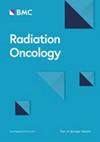Functional imaging guided stereotactic ablative body radiotherapy (SABR) with focal dose escalation and bladder trigone sparing for intermediate and high-risk prostate cancer: study protocol for phase II safo trial
IF 3.3
2区 医学
Q2 ONCOLOGY
引用次数: 0
Abstract
Stereotactic ablative body radiotherapy (SABR) is an emerging treatment alternative for patients with localized low and intermediate risk prostate cancer patients. As already explored by some authors in the context of conventional moderate hypofractionated radiotherapy, focal boost of the index lesion defined by magnetic resonance imaging (MRI) is associated with an improved biochemical outcome. The objective of this phase II trial is to determine the effectiveness (in terms of biochemical, morphological and functional control), the safety and impact on quality of life, of prostate SABR with MRI guided focal dose intensification in males with intermediate and high-risk localized prostate cancer. Patients with intermediate and high-risk prostate cancer according to NCCN definition will be treated with SABR 36.25 Gy in 5 fractions to the whole prostate gland with MRI guided simultaneous integrated focal boost (SIB) to the index lesion (IL) up to 50 Gy in 5 fractions, using a protocol of bladder trigone and urethra sparing. Intra-fractional motion will be monitored with daily cone beam computed tomography (CBCT) and intra-fractional tracking with intraprostatic gold fiducials. Androgen deprivation therapy (ADT) will be allowed. The primary endpoint will be efficacy in terms of biochemical and local control assessed by Phoenix criteria and post-treatment MRI respectively. The secondary endpoints will encompass acute and late toxicity, quality of life (QoL) and progression-free survival. Finally, the subgroup of high-risk patients will be involved in a prospective study focused on immuno-phenotyping. To the best of our knowledge, this is the first trial to evaluate the impact of post-treatment MRI on local control among patients with intermediate and high-risk prostate cancer undergoing SABR and MRI guided focal intensification. The results of this trial will enhance our understanding of treatment focal intensification through the employment of the SABR technique within this specific patient subgroup, particularly among those with high-risk disease, and will help to clarify the significance of MRI in monitoring local responses. Hopefully will also help to design more personalized biomarker-based phase III trials in this specific context. Additionally, this trial is expected to be incorporated into a prospective radiomics study focused on localized prostate cancer treated with radiotherapy. Clinicaltrials.gov identifier: NCT05919524; Registered 17 July 2023. IRAD/SEOR (Instituto de Investigación de Oncología Radioterápica / Sociedad Española de Oncología Radioterápica). Clinicaltrials.gov identifier: NCT05919524; Registered 17 July 2023. Protocol version number and date: v. 5/ 17 May-2023. Date of recruitment start: August 8, 2023. Date of recruitment completion: July 1, 2024.功能成像引导下的立体定向消融体放疗(SABR),采用病灶剂量升级和膀胱三叉神经疏通治疗中高危前列腺癌:II 期 safo 试验的研究方案
立体定向消融体放疗(SABR)是一种新兴的治疗方法,可用于治疗局部低危和中危前列腺癌患者。正如一些学者在传统的中度低分量放疗中已经探讨过的那样,通过磁共振成像(MRI)确定病灶的病灶增强与生化结果的改善有关。这项II期试验的目的是确定在磁共振成像引导下进行病灶剂量强化的前列腺SABR疗法对中度和高危局部前列腺癌男性患者的有效性(在生化、形态和功能控制方面)、安全性以及对生活质量的影响。根据 NCCN 的定义,中危和高危前列腺癌患者将在 5 次分割中对整个前列腺进行 36.25 Gy 的 SABR 治疗,并在 MRI 引导下对索引病灶(IL)进行同步综合病灶剂量增强(SIB),5 次分割最高可达 50 Gy,同时采用膀胱三叉神经和尿道疏通方案。将通过每天的锥形束计算机断层扫描(CBCT)和前列腺内金靶标的分段内跟踪来监测分段内运动。允许使用雄激素剥夺疗法(ADT)。主要终点是生化和局部控制方面的疗效,分别通过凤凰标准和治疗后核磁共振成像进行评估。次要终点包括急性和晚期毒性、生活质量(QoL)和无进展生存期。最后,高风险患者亚组将参与一项前瞻性研究,重点是免疫分型。据我们所知,这是第一项评估治疗后磁共振成像对接受 SABR 和磁共振成像引导病灶强化治疗的中高危前列腺癌患者局部控制效果影响的试验。这项试验的结果将加深我们对在这一特定患者亚群(尤其是高危患者)中采用 SABR 技术进行病灶强化治疗的理解,并有助于明确磁共振成像在监测局部反应方面的意义。希望这也有助于在这种特殊情况下设计出更加个性化的基于生物标志物的 III 期试验。此外,这项试验有望被纳入一项前瞻性放射组学研究,该研究主要针对接受放疗的局部前列腺癌。Clinicaltrials.gov 标识符:NCT05919524;2023 年 7 月 17 日注册。IRAD/SEOR(Instituto de Investigación de Oncología Radioterápica / Sociedad Española de Oncología Radioterápica)。Clinicaltrials.gov identifier:NCT05919524;注册日期:2023 年 7 月 17 日。方案版本号和日期:v. 5/ 17 May-2023。招募开始日期:招募开始日期:2023 年 8 月 8 日。招募结束日期:2024 年 7 月 1 日:招募结束日期:2024 年 7 月 1 日。
本文章由计算机程序翻译,如有差异,请以英文原文为准。
求助全文
约1分钟内获得全文
求助全文
来源期刊

Radiation Oncology
ONCOLOGY-RADIOLOGY, NUCLEAR MEDICINE & MEDICAL IMAGING
CiteScore
6.50
自引率
2.80%
发文量
181
审稿时长
3-6 weeks
期刊介绍:
Radiation Oncology encompasses all aspects of research that impacts on the treatment of cancer using radiation. It publishes findings in molecular and cellular radiation biology, radiation physics, radiation technology, and clinical oncology.
文献相关原料
| 公司名称 | 产品信息 | 采购帮参考价格 |
|---|
 求助内容:
求助内容: 应助结果提醒方式:
应助结果提醒方式:


